Please Report your 2019 Harvest to :
5powderhounds@gmail.com
Thank you,
LWGA Board
There are two great events coming up that you may be interested in attending. The Lafayette Art and Wine Festival is on September 21st and 22nd and the Moraga Pear and Wine Festival is on September 28th. Please come and support our local towns and winemakers that will be pouring at both events. Flyers for both events are below.

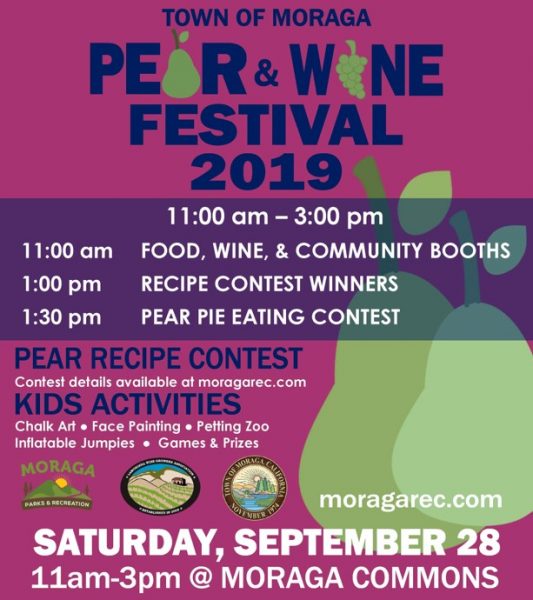
Dear Members,
One of our members suggested that we post where Lamorinda wines are sold or served on the website so that we can support getting our wines more widely known in the community. If you sell your wine commercially or your winemaker does, please reply to this email with:
Once we have this from those interested, we will put this information out on the website.
Thanks,
LWGA Board
| Calling all grape growers! Join Napa RCD for a Hands-onIrrigation Management Workshop, August 27, 9am – 1pm *RSVP Required*RSVP Required Questions? Contact Miguel Garcia:Miguel@NapaRCD.org or 707-690-3122 Sponsored by the CA Dept of Water Resources |
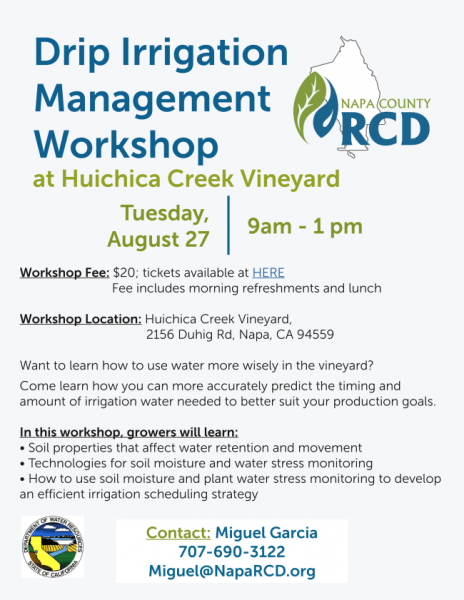
| Napa County Resource Conservation District | 1303 Jefferson Street, Suite 500B, Napa, CA 94559 |
Hello Fellow LWGA Members:
On Sunday, July 28, LWGA held a general meeting at the Howsepian’s in Lafayette. This meeting was well attended and there were in addition a number of prospective members present. Thanks to all that braved the heat to attend, but as it turned out, there was a nice breeze to keep everything comfortable.
After the cocktail and appetizers hour, our President, Bill Scanlin gave us a brief overview of the status of the association, a review of our new LWGA website Forum Posting system, and a friendly reminder of dues for the coming year.
This was followed by a lively discussion and demonstration by Daniel Howsepian as to how to install and operate an electric fencing system in various conditions. A sample ground electric fencing system was set up to illustrate how the wiring can be accomplished, equipment required and an inspection of a real life fencing electric fencing system employed at Raisin d’Etre Vineyard. Many questions were asked and follow through was encouraged.
Following the electric fencing discussion and demonstrations, the white wine winners from our previous member’s choice wine rating event, were there to pour those winning wines and to explain how they were grown and processed. Bill English and David Dicks really know their winemaking and it shows in their wines! A real example of the LWGA Brand potential.
After the demonstrations and wine tasting, a tour was made of Raisin d’Etre vineyard and production facilities which was also well attended.
The evening ended pleasantly with the very comfortable temperatures and a cooling breeze to make the last tastings of the many wines available even more enjoyable.
We thank everyone for the wine and food contributions which made for a great meeting again!
We look forward to seeing you all at our next LWGA Meeting in September.
LWGA Board
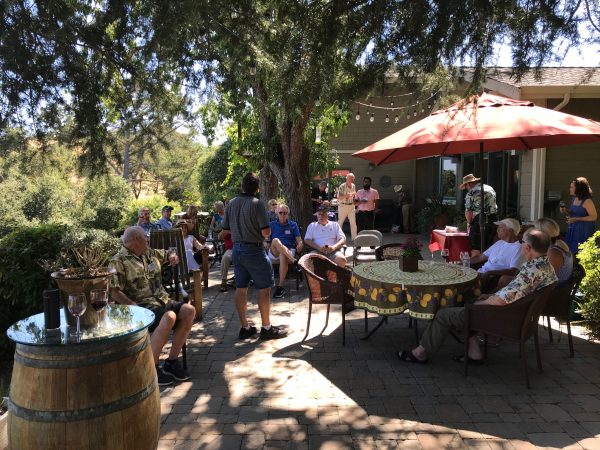
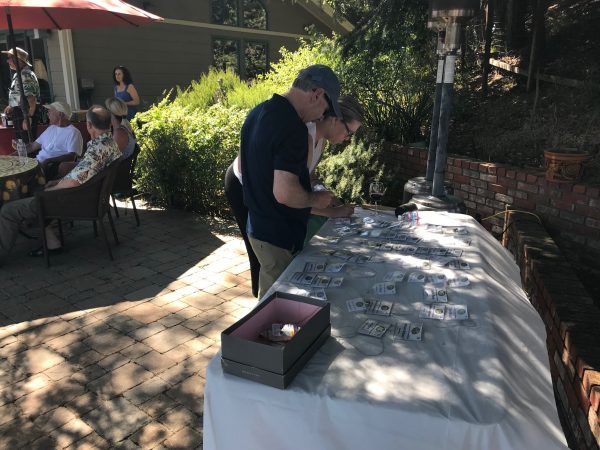

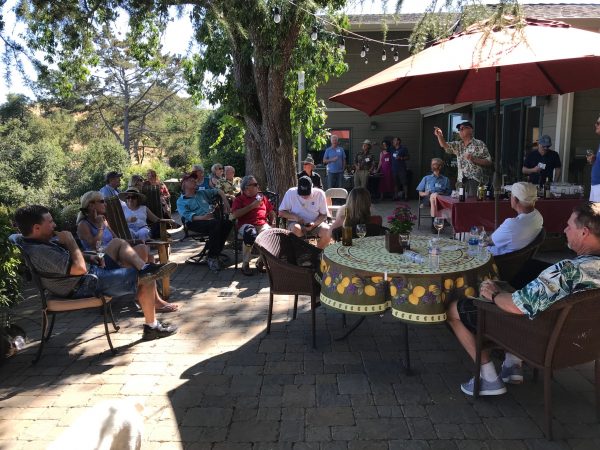
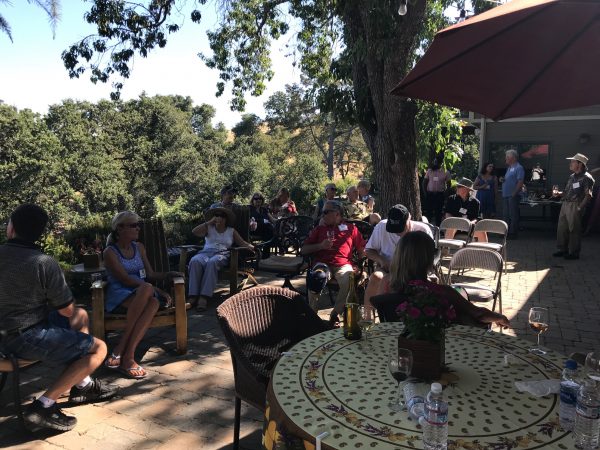
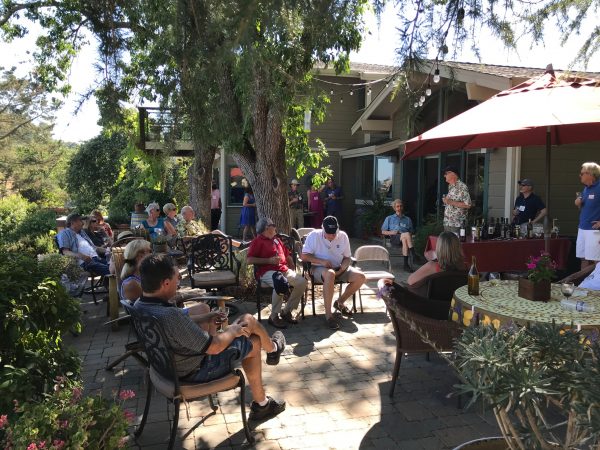
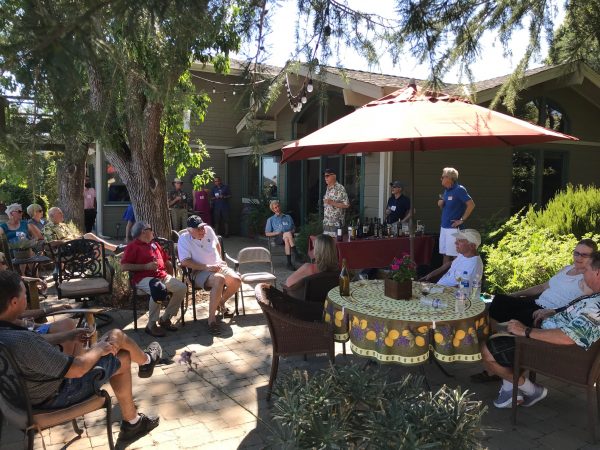
There is a new forum capability that is available on the website for our members that will allow you to communicate with other members and experts in the organization. This will work kind of like “NextDoor” if you are familiar with that community website.
There is a video available that explains how to use forums on our website. The link to the video is: https://www.youtube.com/watch?v=gGjaZsZwDP0
If you have any questions about how to use this feature or have any suggestions, please contact Bill Scanlin at bscanlin@gmail.com and he will get back to you as quickly as he can.
LWGA Board
Again this year, on August 24, Bobbie and Tom Preston will be hosting a tomato and wine tasting fundraising benefit for Habitat for Humanity East Bay/SiliconValley in their Moraga home and garden. When the Prestons did this event in 2017 there were 40 attendees and the event raised almost $4000 for Habitat. The tomatoes will be again contributed by Moraga Gardens Farm. This year Habitat will be handling the PR and it is anticipated there will be 100 guests in 2 shifts (1-3 and 3-5 PM).
The Prestons invite members of the Lamorinda Winegrowers Association to contribute wine to the event; since this year the event will be an official Habitat for Humanity event, the contributions will be tax-deductible.
The Prestons are happy to pick up your donation; you may contact them at 925-376-8474, or at barbarampreston@comcast.net
Hello Lamorinda Winegrowers, Winemakers and Merry Wine Folk!
Our last meeting on Sunday June 3 was a great success. It was well
attended, including by several new members. Everyone seemed to enjoy
the sharing of wines and reconnecting. The talk and slide show on
irrigation and how to identify if your vines are over or under watered
was given by David Hicks, Daniel Howsepian and Gerard van Steyn.
Members kept the presenters busy with many questions, so hopefully
everyone left the meeting with information that can be applied to
improving their grapes and harvests.
If you missed the meeting, the presentation is attached. We encourage
you to review it, since walking your vineyard and monitoring the vines
for signs of under or overwatering is one of the most important things
a vineyard owner can do.
Next Meeting: White Wine Winners and Preventing Varmints from Eating
Your Grapes.
The next member meeting will be on Sunday July 28th, 3pm to 6pm at
Daniel and Anniemeke Howsepian’s house, 3345 Hermosa Way, Lafayette,
CA 94549
The white wine winners from our member’s choice wine rating event will
be pouring their wines and explaining how they were grown and made. We
will also be showing you how to easily install an inexpensive
temporary or permanent electric fence that turns on just at night and
will keep raccoons, skunks and other animals from eating all of your
grapes.
Winegrowers and researchers weigh in on site selection, canopy management, and other strategies to manage growth and ripeness

Winegrowing is very much about balance. A vine needs enough canopy and growth to ripen the grapes, but if it has too much, problems can arise—including ripening issues, ironically. In order to find that balance, understanding and managing vine vigor is essential.
On a very basic level, vigor refers to the amount of growth—shoots, leaves, and grapes—produced by a grapevine over the course of a season. If a vine has many long shoots as well as larger leaves and yields a large crop, it has a lot of vigor. If the vine has trouble growing shoots up to the trellis wires and bears a very limited crop, it’s low on vigor.
Alan N. Lakso, a professor emeritus at Cornell University’s School of Integrative Plant Sciences in New York’s Finger Lakes region, explains that interpreting vigor can be complicated. “If you think of vine shoots, and one is very long and the other one is short, the long one has more vigor, and everyone is on the same page about that,” he says. “However, for the vine as a whole, it’s more complicated. With pruning, if you leave only a few shoots, they’ll grow long and be more vigorous. But the total growth of the plant would be greater on a vine where you left a lot of shoots.” A plant might have more energy than another but show less overall vigor because it’s been pruned back more heavily.

Don’t miss the latest drinks industry news and insights. Sign up for our award-winning Daily Dispatch newsletter—delivered to your inbox twice a week.→
Patricia Skinkis, a viticulture extension specialist and an associate professor at Oregon State University’s College of Agricultural Sciences in Corvallis, also notes that vine vigor can be measured in a number of different ways, such as by the vine’s rate of growth or by winter pruning weight, which is the amount of material removed after the growing season. “The term vigor,” she says, “becomes a matter of debate when it comes to researchers.”
The term vine vigor can also have a different meaning for growers than it does for researchers. “In winegrowing, vigor tends to be interpreted on the high side,” says Skinkis, who notes that most often, the concept becomes a preoccupation when there is excess vigor. “For growers and vineyard managers, it’s about shoot growth, lateral growth, things that need to be managed.
”Although it might seem as though this growth would be beneficial, a vine that has too much vegetal growth—big canes, big leaves, lots of lateral shoots (also known as suckers)—will have a crowded canopy, which creates excessive shade, slows ripening, and hinders airflow, which in turn encourages the growth of fungal diseases. Jason Lett, the owner and winemaker of Eyrie Vineyards in Oregon’s Dundee Hills, once faced such issues in vineyard sections that were closely planted on rich soils. He changed the trellising system to channel the excessive vigor into a more open and widely spread canopy, restoring airflow and reducing disease in the process—and, consequently, improving grape quality. “We used to cut bunches because they were stuck in foliage and had powdery mildew,” he says. “Now, we only cut them when there is uneven ripening.”

If energy goes to shoots and leaves, grape maturity can be affected. Lakso explains that in studies done on Cabernet Franc in the Finger Lakes, ripening problems appeared when there was too much vigor. “Lots of variations were used in the number of shoots and growth levels,” he says, “and what we saw is that when there is more vigor, the grapes retain more methoxypyrazines. White [grapes] tend to be more tolerant of these situations, but in red grapes, the skin-to-volume ratio goes down when there is lots of vigor, meaning [there’s] less concentration—and green character remains.”
However, research conducted by Skinkis in Oregon has shown that crop thinning—dropping grape bunches in order to reduce the crop load and foster better ripening—has limited effects on a plant’s overall vigor. This has led to questions about the usefulness of the practice in achieving the desired results. “It’s likely,” she says, “[that] the plants can hold all that fruit.”
The vigor of a plant also depends on other factors, such as water availability, soil fertility, and rootstocks. “If you go to a vineyard and you see vines that are on shallow soil,” says Lakso, “and others are in deep soil, the ones with more water and more soil will grow more, and the vine as a whole will have more vigor.” Looking at vigor becomes a very different exercise in Virginia, for example, where summer precipitation is plentiful, than in California or Washington, where summers are dry and many growers use deficit irrigation to keep the vines alive and productive.
Nutrients are significant as well. If a vineyard is planted on rich soil, especially agricultural soil that was heavily fertilized, vigor can increase considerably. “Vines really want to grow,” says Lakso. “I once saw a single shoot that measured 62 feet long [growing] around a pergola at a private home. If you give them water and nutrients, they’ll grow like crazy.” In drier climates where resources are less readily available, using cover crops between rows, under vines, or both can create competition for nitrogen, other nutrients, and water, making the technique an effective tool for moderating vine growth where necessary. When water and nutrients are more plentiful, cover crops are less effective at limiting vigor because there’s plenty of resources to go around and all the plants can grow without being in any significant competition.
Jean Hoefliger, a winemaker at Alpha Omega Winery in the Napa Valley and a consulting winemaker for other estates in Priorat and Tuscany, among others, points out that seasonal variations in the availability of water and nutrients can have powerful effects on the vines’ behavior. “This year, in Napa,” he says, “we’ve had lots of rain, especially in May, and that has created a push for very strong vegetative growth in the vines. The water gives the vines a signal that resources are abundant and the plants react accordingly.” But Hoefliger adds that when the vines are set up for abundance, “once the weather becomes hot and dry, the plants have a greater tendency to shut down, which can affect the fruit’s development. The fruit set is also negatively affected because the energy is all going to leaves and shoots.” There are, however, means to manage such reactions to weather changes, like leaving extra shoots on the vines early in the season to capture rising sap and vigor, and then cutting them later on so the plant can shift its focus back to ripening grapes.
Conversely, Hoefliger adds, very dry and hot years like 2003 in Bordeaux or 2015 and 2016 in California can negatively affect the vines’ growth so much that the effect extends into the following vintages. When a plant is insufficiently vigorous, grape quality can also be impacted. “If the vine isn’t strong enough,” he says, “acid drops out very quickly and berries tend to get dehydrated.”

Rootstocks can also exert an influence, and many are cited as either increasing or restricting vigor. It’s hard to draw general conclusions, though. Results of their use vary, especially between wetter and drier climates. Rootstocks that restrict growth in many California vineyards can be fairly generous once planted in the water-retaining Jory soils of the Willamette Valley, or in wetter northeastern U.S. regions. Also, as Lakso points out, the effects of rootstocks on vines are relatively moderate compared with their effects on other plants. “In fruit trees, there are rootstocks that will turn very tall varieties into dwarf trees that stop growing at two or three meters high,” he says. “In grapevines, the effects are nowhere near that.”
At Eyrie Vineyards, Lett has been researching new options for rootstocks in his vineyards, as sections of older, own-rooted vines are succumbing to phylloxera. The search has been proving difficult. “It’s a bit of a tall order to find rootstocks that give you moderate vigor, drought tolerance, and good acid retention,” he says. “Also, when you read descriptions from nurseries, one will tell you that such and such rootstock is drought resistant, and the other one tells you the opposite, and the same thing for moderating vigor.” This has led Lett to try to find his own, distinctive rootstocks—while trying to envision the effects that climate change, causing drier, hotter summers, might have for dry-farmed vines in Oregon.
From site selection to canopy management and the use of cover crops, there are many ways in which winegrowers and vineyard managers can work to achieve the desired vigor—or put another way, the desired balance—of their vines. Though Skinkis cautions that the concept of balance irks some researchers because it’s hard to quantify, she still thinks it’s useful. “It’s a true concept,” she notes. “The vines need to reach a certain balance to ripen fruit and be productive, whether it’s natural balance or something we need to do to help them reach it. We have a lot of control: We can use shoot thinning, leaf removal, hedging, crop thinning, and other means to moderate vigor.” Solutions, however, are far from uniform; approaches used to manage vigor and establish balance need to be specifically tailored. “It’s really based on what you find on your site and in your region,” Skinkis says. “There is a site effect.”
Rémy Charest is a journalist, writer, and translator based in Quebec City, Canada. He has been writing about wine and food since 1997 for various Canadian and American print and online publications, including Chacun son vin/WineAlign, Wine Enthusiast, Le Devoir, Le Soleil, EnRoute, Palate Press, Punch Drink, and Châtelaine, and has been a regular radio columnist for CBC/Radio-Canada. He has also judged national and international wine competitions, notably the WineAlign National Wine Awards of Canada, the TEXSOM International Wine Awards, and the International Rosé Cham
On April 7, 2019, LWGA held another very interesting and fun event at the Lafayette Library. This event was part of our continuing series of meetings as outlined on the LWGA calendar for the LWGA membership.
For this meeting, Members were asked to contribute wines of their making for a peer tasting. We had over 30 entries! Below are the final winners by category:
Other Reds; Three way tie!:
Pinot Noir; Non AVA Winner Meadowview Russian River 2015
AVA Winner Cheery Lamorinda 2016 AVA Winner Ward Lafayette 2014
Red Wines; Cab & Friends;
Cab AVA Winner Deer Hill Lafayette 2016
Syrah; AVA Winner Coletta Orinda 2014
Super T; AVA Winner Meadow View Moraga 2016
White Wines;
Chardonnay Non AVA Winner Ancient Lakes Clear Lake 2014
Chardonnay AVA Winner Meadowview Moraga 2017
Other Whites;
Viognier; Non AVA Winner Ancient Lakes Clear Lake 2014
There were very nice appetizers brought by the members and the wine tasting was a lot of fun and delicious! The consensus of those present was there was not a single bad entry, so the competition was very close indeed. This is a wonderful outcome and shows that the Lamorinda AVA wines are of high quality and can only improve! Our educational sessions with the LWGA meetings hope to aid everyone improve their wine growing and wine making efforts!
Thank you to all who contributed wines for this event!!
At our July 27 meeting, the winners of the White Wine category will have the pleasure of telling us how they sourced their grapes and how they made their wines so we can all have a shot of winning at our next wine tasting event . We will also be able to compare the AVA with non AVA.
The red wine winners will present at our September 29 meeting.
We, on the board, are very pleased to be able to provide these sessions and are very happy to see the level of interest in these topics!
We look forward to seeing everyone for our June 2, 2019 AVA celebration! There will be a special timely, informative viticulture session, about irrigation and canopy management.

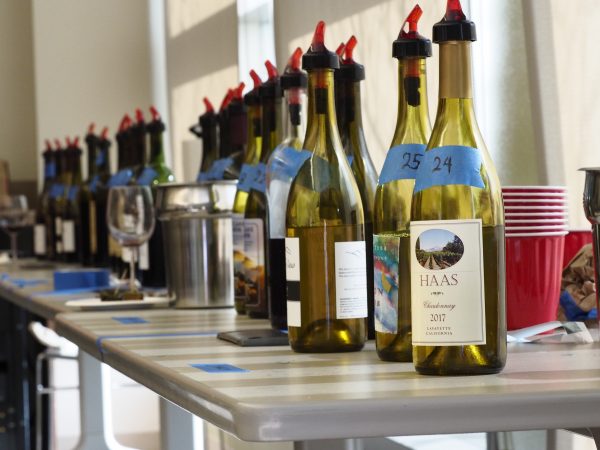
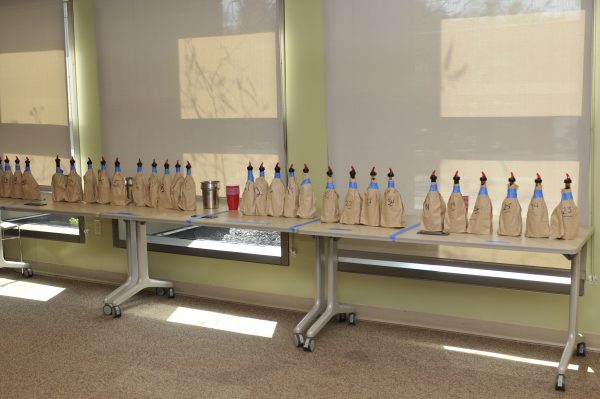
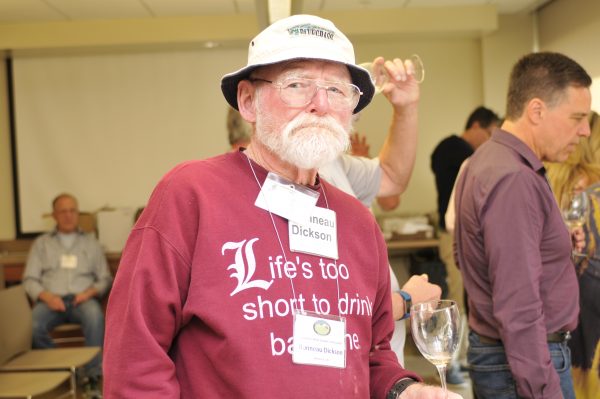
-